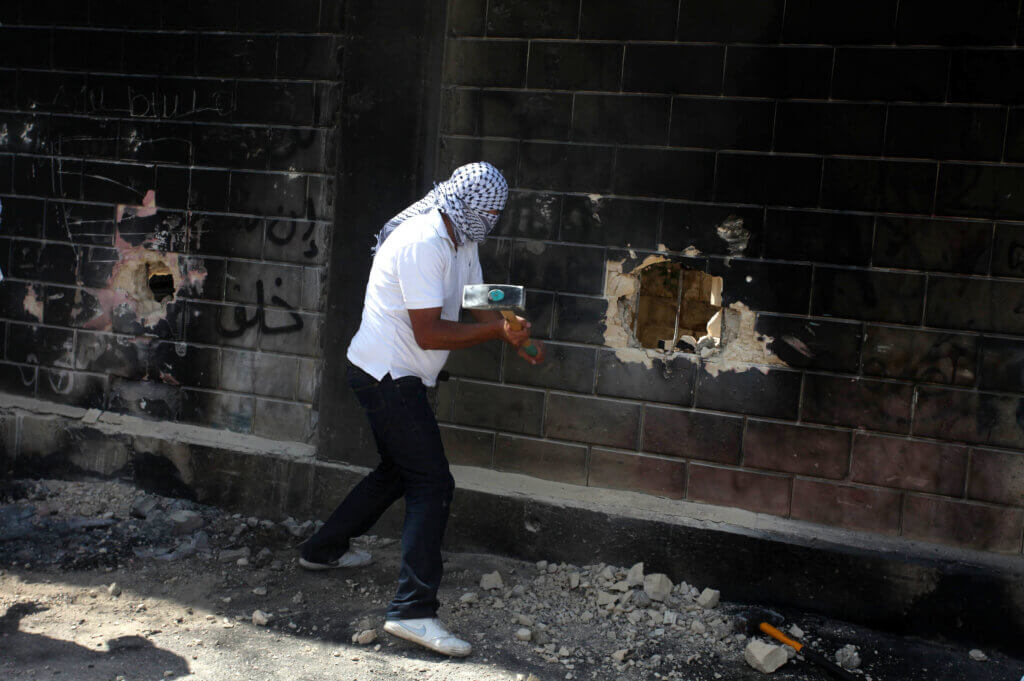Land Ownership under Settler Colonialism – by Dr. Anis Kassim
Land Ownership under Settler Colonialism
On November 29, 1947, the United Nations General Assembly approved Partition Resolution No 181, and thereby endorsed an arrangement that would split Palestine into Jewish (55 percent) and Arab (44 percent) states and place Jerusalem (1 percent) under a special status of corpus seperatum (‘separated body’).
Somewhat perversely, the number of Arabs (528,000) in the proposed ‘Jewish’ State exceeded the number of Jews (449,000),[1] and this was clearly something of concern for Zionists who viewed a Jewish majority as the necessary precondition of a Jewish state. Far from resolving the problem, the Resolution therefore raised the prospect of further conflict. As Ilan Pappé observes, “when an ideology of exclusivity is adopted in a highly charged ethnic reality, there can be only one result: ethnic cleansing”.[2] And Zionist leaders duly demonstrated this when they applied a plan that drove Palestinians off their land, creating a nation of refugees in the process.
The newly established State of Israel then turned its attention to pillaging Palestinian properties. It first enacted the Absentees’ Property Law (1950)[3] that, inter alia, enabled and regulated the comprehensive expropriation of the (movable and immovable) property that refugees had left behind. The Law defines an “absentee” as somebody who:
- Legally owned, enjoyed or held property in what later became the State of Israel in the period 29/11/1947 – 19/5/1948.
- Was a citizen of Egypt, Iraq, Saudi Arabia, Syria, the Lebanon, Transjordan or the Yemen or who resided in any one of these states or any part of Palestine outside Israel.
- Was a Palestinian citizen who left his/her ordinary place of residence in Palestine for a place outside Palestine before September 1, 1948, Or who left his/her residence for a place in Palestine held at any time by forces which either sought to prevent the State of Israel from being established or that later fought against it after its establishment.
The definition distinguishes two categories of Palestinians: The first refers to those absent from Palestine in the period between November 29, 1947 (the date of the UN Partition Resolution) and May 19, 1948 (when the state of emergency ceased to exist). When Palestinians who sought refuge in neighboring countries or were temporarily absent (e.g. for a business trip or study-related reasons) returned, they were labelled as absentees and their properties were transferred to the Custodian.
The second (and more exceptional) category includes those who remained in the area that fell under the control of the Israeli army, but who sought refuge in any place adjacent to or close to their village or town. These Palestinians were later referred to as “present-absentees”.[4] Although they are now recognised as physically present and are Israeli citizens with certain social and political rights, they will revert to the status of “absentees” if they try to claim any part of their property. And this is how the Law continually reproduces discrimination.
The Law defines the “area of Israel” as “the area in which the law of the State of Israel applies”. Israel is probably the only country in the world that has not officially defined its own borders, and so it follows that when Israel’s laws are applied in the course of colonial expansion into the West Bank and Golan Heights, land confiscation will necessarily follow. The Law establishes the absentees’ property will be “vested in the Custodian” and that he/she will “automatically” receive “every right an absentee had in any property”. The Custodian and the property owner therefore have the same status, which means the former will henceforth be the “owner” of the absentees’ property and, as such, will have the unfettered right to dispose of it as he/she sees fit.
The Law also directs the Custodian to “sell or otherwise transfer the right of ownership thereof; provided that if a Development Authority is established under a Law of the Knesset, it shall be lawful for the Custodian to sell the property to that Development Authority…”.
In July 1950, the Knesset passed the Development Authority (Transfer of Property) Law,[5] which establishes that the Development Authority “shall not be authorized to sell, or otherwise transfer the right of ownership… except to the State, to the Jewish National Fund, to an institution approved by the Government…”. And the Jewish National Fund (JNF) always has the right of first refusal when a real property is offered for sale.[6]
In 1960, Israel sought to safeguard the Judaization of the land by enacting a Basic Law (Israel Lands) and the Israel Lands Law. The former establishes that the ownership of Israel lands, “being the lands in Israel of the State, the Development Authority or Keren Kayemeth Leisreal, shall not be transferred either by sale or in any other manner” [emphasis in original].[7] This gives effect to the “perpetual ownership” of the “Jewish people”. And the latter defines “Israel Lands” in the same terms as the former, and thereby ensures that no land will be transferred to its legitimate Palestinian owners.[8]
These laws and their related apparatuses expropriate, dominate and divide land on the basis it is “only property for Jews”.[9] As a consequence, around 93 percent of Israel’s land is the property of the State. This, and the fact that hardly any compensation was paid to the legitimate Palestinian owners, helped to make Israel a viable settler colony.
The Absentees’ Property Law gave the Custodian the power to transfer land to the Development Authority, whose law gave it the power to transfer land to the JNF, whose basic document in turn gave it the power to, inter alia, buy land for Jewish-only settlements in Palestine.[10]
The recently enacted Nation State Law[11] refers to this self-established claim to expropriated land as a “national value”, a euphemism that is clearly intended to whitewash the colonization process. However the Israeli legislature’s efforts to remove the original sin by relocating it from one location to another, which have an unfortunate resemblance to money laundering, will quite clearly fail to purify it, and it will instead remain sinful.
After its resounding victory in the 1967 War, the Israeli government initiated a well-organized and aggressive colonization of the oPt (Occupied Palestinian Territories). The Government initially sought to justify its settlement drive by invoking a “security” pretext that presented the settlements as integral to national defence, and this was accepted by Justice Vitkons in Israel’s High Court of Justice. However, as Eyal Weizman observes, this rendered settlements as “legitimate targets for attack”:[12] settlers did not just passively consume IDF (Israel Defense Forces) security, but instead actively contributed to it.[13]
By 1977, settlers had already formed armed ‘settlement security units’. In Al-Aqsa Intifada, the military relocated some of its bases into these settlements and settlers from the “security unit” were present at military briefings and debriefings.[14] This military-civilian nexus is now a well-established part of the colonization process in the West Bank. The creation of settlements does not just serve a security purpose but also further entrenches the notion of “Jewish right”, and this is precisely why Israel’s official discourse goes to great lengths to reassure us that these settlements are not built on occupied territory but are instead constructed on “Eretz Israel”.
[1] – Plenary Meeting of the General Assembly, 126 th Meeting, 28 November, 1947, UN Official Record, Vol. 2, pp. 1390-1400.
[2] – Ilan Pappe, The Ethnic Cleansing of Palestine p. 35 (2006)
[3] – Text in 4 Laws of the State of Israel, p. 68(1950)
[4] – Nur Masalha, The Politics of Denial pp. 153-158 (2003).
[5] – Text in 4 Laws of the State of Israel, p.151 (1950).
[6] – See the Basic Documents of the Jewish National Fund in II The Palestine Yearbook of International Law, at pp. 194-216 (1985).
[7] – Id, p. 217
[8] – Id., p. 218
[9] – See the arguments put forward by the JNF’s counsel in the JNF’s responses to the High Court of Justice in Cases No. 9010/04 and 9205/04 (English translation provided by Adalah). Here it was argued that funds donated by Jews from all over the world were given only “for the purpose of purchasing land in Eretz Israel to be held and developed on behalf of the Jewish people.” p. 82.
[10] – Refer, in general, to the Law in note 3 supra (with particular emphasis on Arts 2/a; 4/a; 17, 19); also refer to the Development Authority Law, and Arts 3/4/a &b in particular.
[11] – See The Times of Israel, Oct. 17, 2018.
[12] – Eyal Weizman, The Hollow Land – Israel’s Architecture of Occupation, pp. 99-100 (2007).
[13] – Id. Note 26, p. 283.
[14] – Id.
Dr. Anis F. Kassim
Dr. Kassim started his university studies in Damascus, then moved to the United States, where he obtained his doctoral degree (S.J.D) in law from George Washington University in 1973. He worked with Sun Oil Company (now Sunco) in Philadelphia from 1973 until 1975, then as the legal counsel to the Industrial Bank of Kuwait (KSC) from 1975 to 1977. He became a partner and manager of a law firm called Al Saleh, Graham & James Legal Consultants in Kuwait from 1977 until 1991. Dr. Kassim currently works from his legal office in Amman. He served as a judge at the Administrative Tribunal of the Arab League between 1981 and 1984. Dr. Kassim was editor-in-chief of the Palestine Yearbook of International Law from 1984 to 2000, and still serves as an editorial advisor. He was a member of the Palestinian defense team in the case against the Israeli separation wall at the International Court of Justice. Between 1997 and 2007, he represented the Jordanian government and the PLO before the United Nations Compensation Commission to assess the damages inflicted by the Gulf War of 1990 on Jordanian and Palestinian individuals and corporations. Dr. Kassim also served as a legal adviser to the Palestinian delegation in the peace negotiations held in Madrid and Washington from 1991 to 1993.



